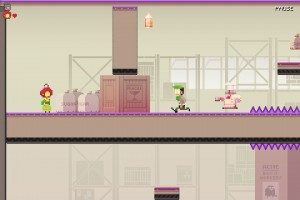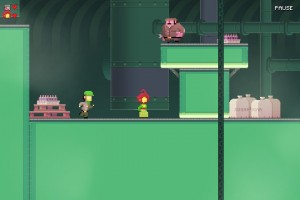Let’s start out by learning a little about the man behind the Initials logo. We hear that you’re a visual effects artist by day and an indie game developer by night – just how long have you been doing this, and do you find that your day job has given you skills that help with game design?
I’ve been in advertising and post production in various roles for six years now. Working in a related field, but not in a video game company, has put me in a position to deliver unique games. Everything that is involved with visual effects and 3D animation can be applied to making a video game. From coding to asset management, even right up to running a project successfully, are all things that I’ve learned how to do effectively from my day job.
Also, being surrounded with talented and dedicated people is quite inspirational!
 Tell us a little about your experience with the Flixel game engine. We were pretty impressed to find not only side-scrolling games among the Flixel projects released so far, but also isometric 2D, board games and even visual novels. How easy is it to pick up, and where do its limitations set it? Would you say it’s capable of virtually anything 2D but not 3D?
Tell us a little about your experience with the Flixel game engine. We were pretty impressed to find not only side-scrolling games among the Flixel projects released so far, but also isometric 2D, board games and even visual novels. How easy is it to pick up, and where do its limitations set it? Would you say it’s capable of virtually anything 2D but not 3D?
Flixel is an incredibly versatile engine, open source, and able to be built upon with customizations, which is why you see such a diverse range of games.
For those unfamiliar with the engine, Flixel was coded by Adam Atomic of Canabalt fame, written in ActionScript 3.0 and then brought to iOS by his Semi Secret Software company. It’s my engine of choice for many reasons, and one of them is that it’s so easy to pick it up and start making games. It is a 2D engine and if you’re interested in making a 3D game, Flixel isn’t going to be a good choice.
 It looks like Super Lemonade Factory is your biggest Flixel project so far, but what were some of your earlier experiments in this engine, and did you take a lot of lessons away from these that you later applied to Lemonade?
It looks like Super Lemonade Factory is your biggest Flixel project so far, but what were some of your earlier experiments in this engine, and did you take a lot of lessons away from these that you later applied to Lemonade?
Before starting Super Lemonade Factory, I worked on some smaller games until I felt I had a firm enough understanding of how everything works. The biggest lesson I learned was to let people test my game, and listen to their feedback. It’s so easy to get stuck in a bubble and become concerned with minor imperfections and lose sight of the bigger picture. I distributed the game to a small number of people using TestFlight and had a great response.
Being patient with release was something else that I learned along the way. I had great support from Chris at Surprise Attack, who encouraged me to polish the game rather than release it early.
What inspired you to set Lemonade in post-World War II Europe (or at least, we think it’s Europe)? Did historical research end up affecting anything in the game, big or small?
The game is set in a European colony after World War II. I won’t say exactly where, because the discovery is part of the story. All the parts of the story are quite subtle and may require some research on the part of the player, and this is very deliberate. The way I tell the story shows respect for the player; I don’t think stories need to be spelled out.
The story is very much an optional part of the game. You can play every single level and not bother with the story, or you can delve into who these people are and where they live and what gets them out of bed in the morning. As for inspiration, it’s a case where many people I have talked to don’t know much about this part of history, and I felt like there’s a story to tell here.
 Did you intend to include the character switching mechanic between Andre and Liselot from the beginning, or did that idea arise sometime after you started developing Lemonade? Were there any gameplay ideas you couldn’t fit in, but might appear in updates or future Initials games?
Did you intend to include the character switching mechanic between Andre and Liselot from the beginning, or did that idea arise sometime after you started developing Lemonade? Were there any gameplay ideas you couldn’t fit in, but might appear in updates or future Initials games?
When I first saw the sprites for the characters that Miguelito created, I knew I couldn’t have either one as only a background character. The game design evolved from there.
I wish I could say I set out with a firm design document to create a game that was based on teamwork and equality, but the game really evolved over time. Implementing the character switching mechanic was really a pivotal point in the development process. It’s when I realized I could make a game that showed how a couple in a relationship, or a team, could be greater than the sum of its parts.
The gameplay feature that I couldn’t fit in was angled tiles. The levels in Super Lemonade Factory are very blocky, and that’s great — some of my favorite platformers are exclusively blocky. There were performance reasons to keep it this way. Angled tiles are definitely on my wish list though, along with two player wireless.



